Cucumber is a commonly growing crop, that usually being planted from transplants or seeds. But did you know that there is a successful way to grow cucumbers from scraps? That’s what I’m going to explain to you today.
Here are the exact steps of how to grow cucumbers from scraps.
- Take a ripen cucumber and wait until seeds mature
- Cut the cucumber into slices/scraps
- Prepare a potting soil and a basket to plant cucumber scraps
- Dip the cucumber scraps into the potting soil on the basket
- Wait until cucumber scraps grow seedlings and transplant them to a final location
- Do watering and fertilizing cucumbers regularly
- Train cucumbers to run on a trellis
- Pollinate cucumber plants
- Now harvest the cucumbers
All you need to grow cucumbers from scraps is just a well-matured cucumber. In the end, you are going to have a massive crop as usual. I’m sharing my personal experiences and secrets of growing cucumbers from cucumbers. Keep reading!
Table of Contents
Required conditions to grow cucumbers from scraps
Before we get into the exact steps of growing cucumbers from scraps without seeds, we need to know about the overall conditions that the cucumber plant needs to grow.
Especially you have to work with extra caring these conditions when you are growing a plant in an abnormal way like growing a cucumber plant from another cucumber fruit.
Soil
Cucumbers are likely to grow on loamy and loose soil that is fertilized enough. And also soil should have the capability to absorb enough water, but drain at a specific time period. Cucumbers love to feel a little bit moist on the soil, but not for wet soil surrounding all day.
These cucumbers are showing their best performance with soil Ph between 6.5 7.0, which is slightly acidic to neutral.
I am using the method to prepare the soil, mixing some composts and some other kinds of organic matter with my garden soil. And also I’m ensuring that my soil mixture is well-draining.
And also remember that you have to work on preparing the soil for at least two inches deep. Because cucumbers having such an extended rooting system, the deeper you provide the nutrients, the better the strength of the roots.
But what else you should do if your garden soil is something heavy, like clay?
It’s just that easy. First, dig the soil and make them a little bit loose. Then mix the clay soil with some sand. Now you can again mix the fertilized soil mixture amended with compost or organic matter. ( Don’t use clay to prepare the rich fertilized soil mixture. Always use normal garden soil )
Watering
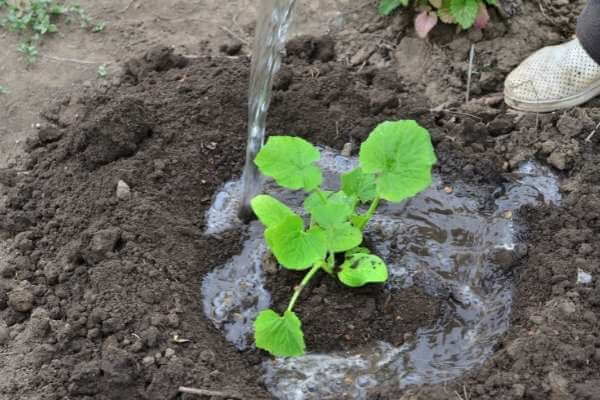
When you are planning to grow cucumbers from scraps or any other method, watering is doing a major role in the overall quality of the fruit.
Especially crops like cucumber, zucchini, and watermelon have plenty of water composition inside the fruit. So both underwatering and overwatering matter the final output of the crops like cucumber. Let’s see how we can get the most out of watering.
Here’s how much to water your cucumbers?
In milder weather conditions cucumber plants need 1 inch of water per week. However, in the summer season watering 1.5 – 2.0 inches of water would be ideal for cucumbers. Always increase or decrease watering based on rain, temperature, and humidity.
When you are watering cucumbers, keep watering until the water soaks deeply onto the soil. And also make sure the water will be drying out.
The safest time to water your cucumber plants is, in the morning. Because the plant can absorb enough water and excessive moisture will be dry out under the sun.
But watering your cucumbers at night or late evenings do more harm than good. Here’s why.
Here’s a tip:
When I watering my cucumbers, I feed more water at once, but not watering too often. That’s a great technique to follow when watering warm-loving crops, because by doing that we aren’t distracting the soil temperature again and again.
What happens when you overwater a cucumber plant?
The main outward-pointing feature of overwatering a cucumber plant is powdery mildew on large and older cucumber leaves. It tends cucumber leaves to turn yellow and looks wilted because of lack of Oxygen on the soil. Even though cucumber fruits don’t affect powdery mildew directly, due to the loss of cover from the protected leaves cucumber fruits can burn out from the sun.
Also overwatering a cucumber plant growing from scraps tends to produce more water-flavored fruits that aren’t that tasty.
What happens when underwater a cucumber plant?
Underwatering a cucumber plant basically makes its leaves and stems turn brown and doesn’t set up fruits from the flowers or mature the existing fruits. Overall the cucumber plant looks dry, wilted, and going to die. Also, cucumber plants can be infected from blossom end rot when you do not water them enough. Many cucumber plants can get back to life after being underwatered if you provide enough and consistent watering.
fertilizing
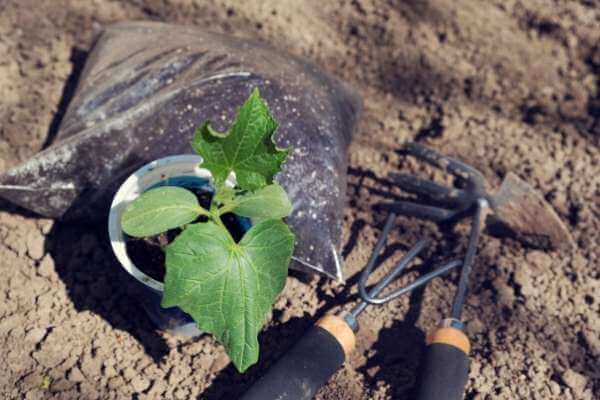
As summer crops, cucumbers are heavy feeders. That’s why they need to be grown on rich and fertilized soil. Apart from soil preparation, we can implement some other fertilization for cucumbers to boost their growth.
In the earlier season of growing cucumbers from scraps, I recommend you use an all-purpose fertilizer rich in Nitrogen. Nitrogen is always ready to work with making the roots healthier and also helping with making the growth of the plant faster.
10:7:7, 7:5:5, or 7:3:3 NPK fertilizer would be a good start for cucumber transplants that is at least 3 inches tall. Apart from these commercial fertilizers, you can also use compost and coffee grounds as fertilizers for cucumber transplants, which are recognized as high Nitrogen fertilizers.
But when your cucumber plant getting into its growing season, you have to cut down the Nitrogen gradually. It will help the cucumber plant set up the fruits from the flowers, but not grow the stems or leaves anymore.
Temperature & Sun
The ideal temperature to grow cucumber from scraps, seeds or transplant is between 65 F – 75 F. Required soil temperature for growing cucumber is averagely 60 F.
Cucumbers aren’t cold-tolerating crops. Therefore they are rarely not setting fruit when the temperature goes below 50 F.
Same as the environmental temperature, cucumbers love the warmness of the soil. Because of that, sometimes cucumbers showing decreasing in growth and fruiting of the plant in low-temperature soil conditions.
When considering sunlight requirement, there is no other plant that loves sun, as much as cucumbers. Cucumbers need full sun to make the most out of their growth.
I’m always trying to locate my plants, where they can have 8 or hours of sunlight a day.
Usually, cucumbers taking 50 – 70 days to produce their fruit, and it’s a long growing season comparing to other growing crops.
By considering that and all the above environmental facts, we can recognize summer or spring will be the best two seasons to grow cucumbers from scraps.
How to grow cucumbers from scraps
Great! Now we are ready with the required conditions to grow your cucumbers. Now let’s jump into the exact step-by-step process to grow cucumbers from scraps.
Take a ripen cucumber and wait until seeds mature
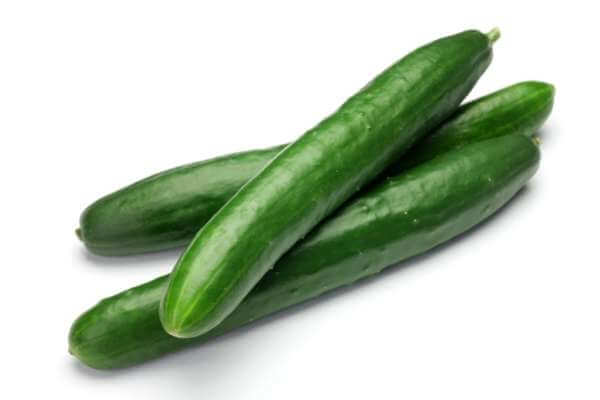
As the first very easy step, you have to find a well-matured cucumber that is in good condition.
When choosing a cucumber fruit to grow cucumber from scraps, there are some things to note about. They will help you to find a good cucumber that having healthy and growable seeds.
- The fruit you use to grow cucumber cuttings should be a natural variety. Hybrid and many artificial cucumbers can’t be used to regrow new plants from them.
- The cucumber you are using to take scraps shouldn’t be a diseased one. If it does a diseased fruit, its seeds can’t produce a plant, or even they grow a plant they will be failed to fruit or get infected with diseases.
Can you grow cucumbers from store brought cucumbers?
Most of the time store brought cucumbers are F1 Hybrid varieties that aren’t “breed-true”. A new cucumber plant can’t be grown from a Hybrid variety that is unbreedable. But if the store brought cucumbers are natural variety, growing cucumbers from store brought cucumbers possible thing to do.
After choosing the right matured cucumber, you have to place it somewhere it doesn’t get sunlight, for 4-5 days. By doing that you can mature the cucumber seeds quicker and make them ready to grow.
Cut the cucumber into slices
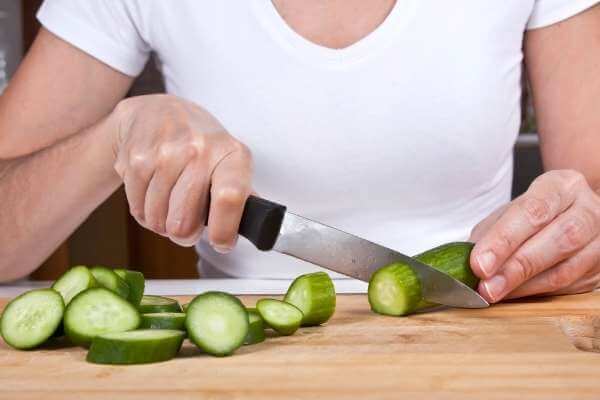
After you complete leftover the cucumber and giving some time to mature the seeds, now you can cut the cucumber fruit into slices.
First, remove both the top and the bottom parts of the fruit. They won’t be growing plants because they have no seeds.
Then cut the rest of the fruit into slices as the thickness is 0.5 inches of each. Now, these are the cucumber cuttings that you are using to grow cucumber from scraps.
Now you can use these cuttings straight into the soil to grow new cucumber plants, or you can take out the matured seeds from the cuttings and grow them separately.
Always when I regrow food from scraps, personally I prefer to grow the plant directly from the cutting. Because the seed is well adapted to the fruit for a long time, let it grow with the fruit, may tend to feel it more comfort.
However, if you observe a cutting, you can find that there are two types of seeds inside of that. Ones are feeling really soft with a cover like jelly. And the other ones feel a little bit harder.
Those harder seeds are the well-matured ones that able to grow a cucumber plant from scraps. Soft seeds couldn’t grow any new plants.
prepare the potting soil and a basket
Now you need to prepare a potting mix and find a basket to get started with growing cucumber from scraps.
First, let’s prepare the potting soil to start growing cucumber from their cuttings.
I recommend using 50% garden soil for the potting soil mix, which is amended with compost, and 50% normal sand.
Once you prepare the potting soil mix, now you have to get ready with a basket or a basin to grow those cucumber scraps. Whatever basket you are using should have a good drainage system and at least an 8-inch diameter to manage good space among cucumber cuttings.
Dip the Cucumber scraps on the soil
Now fill in potting mix for 3/4 of the basket and place the cucumber scraps. Then, add some fungicide powder onto the cucumber scraps only if you have them right now. That is not compulsory. It’s totally optional and it will give a better and quick result.
After that cover the cucumber cuttings from a 1-inch layer of the same potting mix. Don’t make that soil layer too thick. Otherwise, it will work as a barrier to the seed germination process.
You have to add some water onto the soil as soon as you dip cucumber scraps on the soil. Then keep the basket in a partial shade area. Don’t try to provide direct sunlight even cucumbers love them. It will help the seeds to get rid of that shock of being planted.
After 5 to 7 days, you will be able to see some seedlings from 1-2 inches tall. This will totally depend on the seed germination, and all the environmental facts affect the seed germination.
Usually, it takes 10-12 days to complete the germination process of cucumber seeds. So as I observed you will be able to have, closely 8-inch cucumber vines from 15-20 days.
Now, these are the cucumber plants you have grown from the scraps. You can’t grow them anymore in that 8-inch diameter basket. The time has arrived to move the plant into the final location.
Transplant seedlings in the final location
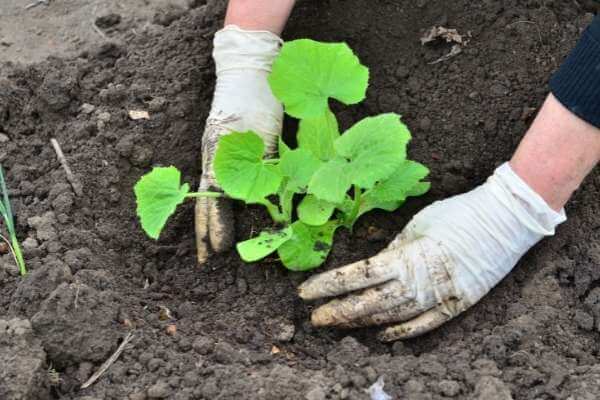
To transplant cucumbers that you have grown from scraps in the final location, first, you have to take out the cucumber plants from the first growing basket.
That is a really challenging task because many cucumber vines on that one basket and their roots travel all around. So the damage to the roots should be minimized.
First, gently loosen the soil around the plant, using a garden hand folk. Then remove the soil by hand to a depth of about 2 inches and drive the roots well.
Hold one hand in the middle of the plant and hold the main root of the plant with the other hand. Now drag off the plant gently from the main root.
So how you can take out the cucumber plants safely? Here’s what I do!
After you take out all the cucumber plants, let’s see how you can transplant them in the final location.
How to transplant in the final location
First of all, you have to find a location to transplant cucumber plants. As cucumbers need a lot of sunlight, you have to find an open location that has direct sunlight to grow cucumber from scraps.
But there’s a catch.
When you move a plant from one place to another, that plant has a transplanting shock. It takes few days to get rid of that. Usually, we don’t expose newly moved or transplanted plants into direct sunlight due to that transplanting shock.
In this case, you have no other option. The only solution is shading the plant for some days by using a shading net or cloth. That will save the plant from hard sunlight while the plant getting rid of that transplanting shock.
Now you are ready with the location. Let’s see how to plant them on the final location.
Before planting, You have to prepare the soil for cucumbers. As I mentioned earlier in this post, try to prepare nutrient-rich, loose, and well-draining soil.
- First, till the soil simply using a hand folk. Then dig a hole that is at least 6 inches deep. If you find the soil is not that loose, try to make the soil loose by using this techniques.
- Now fill in a 3-inch layer of compost for the bottom of the hole. Now put the cucumber plant into the hole and fill the rest of the hole from normal garden soil.
Only 2-3 inches from the plant should stay above ground level. - Then water the plant well.
When you have completed the above steps, make sure that you are covering the cucumber plants from the direct sunlight during the day.
Treating the cucumber plants
After you’ve all done with planting the cucumbers, which is the main part of how to grow cucumbers from scraps, you have to keep treating the plant with consistent watering and fertilizing.
You have to keep watering your cucumbers at least 1 inch per week. And I always recommend that increase or decrease the watering based on environmental facts such as rain, heat, and humidity.
When we turn to fertilize, personally I fertilize my cucumber plants every two weeks based on the nutrients and the quality of my soil.
The consistency of fertilizing should completely rely on the quality of the soil. But I tried to bring you a fair number to identify how often to fertilize cucumbers.
I asked, “How often to fertilize cucumbers?” from a group of cucumber growers. They replied me relying on the quality of the soil of their backyards.
Someone said once a week, some others said every 10 days, and also some gardeners have fertilized cucumbers for 2 weeks, and even a month often.
According to all the data they provided, I suggest you keep fertilizing cucumbers every 10 days.
Furthermore, in the foliage growing season, you can fertilize less often with more Nitrogen. But in the fruiting season, you have to work on more consistent fertilizing for cucumbers.
Train them to run on a trellis

Training cucumbers to run on a trellis is so important and effective as my years of experience in growing cucumbers.
Don’t just trust me. I just ask out 24 cucumber growers about what is the most productive way to grow cucumbers?
I gave them running on the ground and running on a trellis as two options.
Here’s what I got.
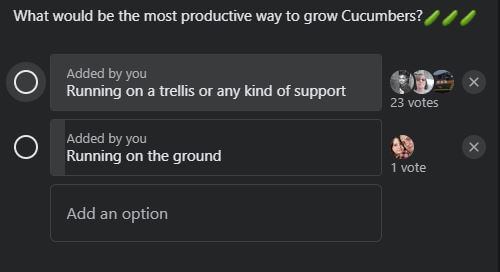
The result was surprising. 23 out of 24 gardeners recommended growing cucumbers on a trellis and they proved to me that it was more productive and safer than just running them on the ground.
Actually, there are some advantages of growing cucumber on a trellis. Believe it or not, it can even impact the health of the plant. Here are some of them.
- If you running cucumber vines in the ground, some leaves couldn’t have enough sunlight for Photosynthesis. And also, sometimes leaves staying wet after raining or watering because of lack of sunlight for the leaves. This may tend the cucumber plant t get infected by powdery mildew disease.
- But if you run cucumber vines on the trellis, all parts of the vine getting good airflow and enough sunlight. And it will save the plants from various diseases.
- The next golden advantage is saving you space. By trellising your cucumbers, you can grow more cucumbers in less space. Otherwise, cucumbers need a lot of ground space to grow.
- Also, by growing cucumbers on a trellis give you ease of harvesting.
So, from what you need to do trellising when you grow cucumbers from scraps?
For trellising cucumbers, you can use a Nylon trellis, tomato cage, or even a chain-link fence. You can use anything that supports them to hang on.
I use Nylon trellising for cucumbers because it’s easy to set up and also it’s fairly cheap.
Here’s how you need to train cucumbers on a trellis.
To train your cucumbers on a trellis, you have to wait until the plant gets at least 1 foot long.
Now grab the top of the vine by the hand and gently wrap it two or three times around the trellis. You also can tie out a stem into a trellis using a twine.
That’s all you need to do. Cucumber vine will run on the trellis using their tendrils.
Pollinate your cucumber plants
Now the next main step in growing cucumbers from scraps is pollinating. As cucumbers having a long growing season, increasing the pollinating of cucumbers could make that period shorter.
Cucumbers are mainly pollinating by the wind. And also pollinators such as bees are doing a major role in pollinating cucumbers.
The best way to help increase cucumber pollination is trellising. It will well expose the flowers into the air and give the best chance for pollinating.
Grow some pollinator-attractive flowers near your cucumbers. I grow Daisy, Dhalia, and Coneflowers.
Cucumbers are self-pollinated. But in my experience of growing cucumbers, pollens from different cucumber plants always make the crop healthier and also increase the yield.
Therefore working on hand pollinating for cucumbers is really worth it. The below video will guide you on how to hand pollinate cucumbers.
That’s how you have to work on pollinating when you grow cucumbers from scraps. If you have done all right with pollinating your cucumbers, you can jump into pick a fantastic harvest of cucumbers.
Harvest cucumbers
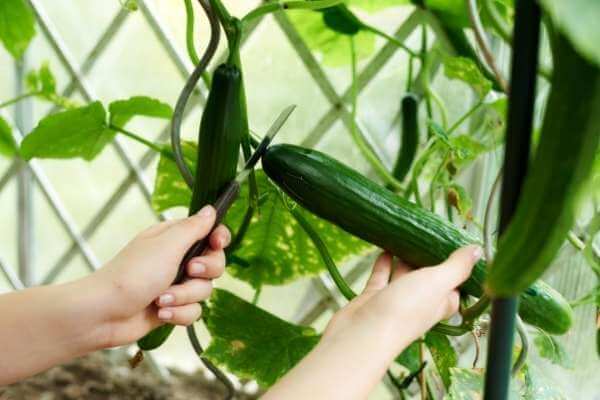
There are different varieties of cucumber and they are taking different time periods to mature their fruit. But as an average, cucumbers take 60 – 70 days to mature their fruits.
Sometimes fruit maturing process can happen earlier in this period or it can happen at the end of this period. Therefore you have to keep in touch with the fruits on your cucumber vines.
When to harvest cucumbers from the vine?
As cucumbers aren’t ripening after cutting early from the vine, cucumbers should be harvested when they are in color between medium green to dark green and at least 5 to 8 inches long. Cucumbers take 60 – 70 days to ripen as harvestable. Yellowed, having sunken areas, and puffy cucumbers shouldn’t be harvested.
Even if you harvest over matured cucumber, maybe still you are okay. But not at all right!
Over ripened cucumbers, taste watery, unlike newly ripen young cucumbers.
As Kelloggarden suggests, morning is the best time to harvest your cucumbers off the vine. Morning is when fruits look more comfortable.
How to harvest cucumbers from the vine?
Grab the cucumber from one hand, and cut it out from the stem about half an inch using a sharp knife. Grinding or pulling off the cucumber by hand can cause treating the stem and it could damage the rest of the plant growth.
If you are coming to the end of the growing season, for example, if you getting closer to frost, you can cut off the new flowers and all non-fruiting stems on the vine to save energy.
By doing that, the plant can provide its best to mature the currently hanging cucumbers. It will help you to get the most out of your cucumber plants.
That’s how you have to harvest your cucumbers at the end of growing cucumbers from scraps.
Save seeds for the next time
Once you going to pick up all the cucumbers, you can leave one cucumber to over-ripen in the vine if you are willing to grow cucumbers in the next growing season too.
You can take out the seeds from that cucumber fruit as same as I mentioned earlier in this post, and grow some incredible cucumber seeds the next spring or summer.
Happy growing!
